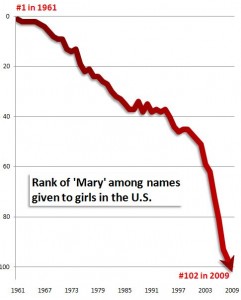 Philip N. Cohen, professor of sociology at the University of North Carolina at Chapel Hill, recently wrote two posts (A and B) on his blog about the declining popularity of the name Mary. To put the trend in perspective he offers these remarks:
Philip N. Cohen, professor of sociology at the University of North Carolina at Chapel Hill, recently wrote two posts (A and B) on his blog about the declining popularity of the name Mary. To put the trend in perspective he offers these remarks:
- For the first time in the history of the United States of America, the name Mary is not in the top 100 given to newborn girls.
- Mary was the #1 name every year in the Social Security name database from 1880 — it’s first year — to 1961 (except for dropping to #2 to Linda, 1947-1952)
- In the past 5 years the number of girls named Mary at birth in the United States has fallen at a rate of 8% per year, reaching an all-time low of 3,105 in 2009
So What?
Interestingly, membership in mainline Protestant denominations peaked in the 1950s. The decline (in membership and role in the larger culture) in the mainline follows the path of Mary (or one could rightly say the decline of Mary follows the path of the mainline). At any rate, neither has the role it once did and neither should anticipate a reversal in the near future. Both exist in a much more diverse culture.
- Name Diversity. Cohen notes that “the top 20 girls names were 34% of the total in 1940s, but they now represent just 12%. Isabella, today’s #1, was given to just 1.1% of girls in 2009. In 1961 Mary was given to more than twice that proportion, 2.3%.”
- Religious Diversity. The fastest growing religious group are nones or those who claim no formal religious affiliation, which now account for 16% of the adult population.
What are some other examples of things that have moved from the center to the margins following roughly the same timeline as the popularity of the name Mary and the membership and influence of the mainline Protestant denominations? How might you use incorporate such a list of items as a means of more effectively telling the story of the history of the mainline church over the last few generations?